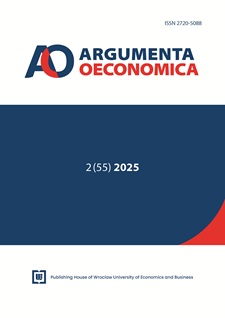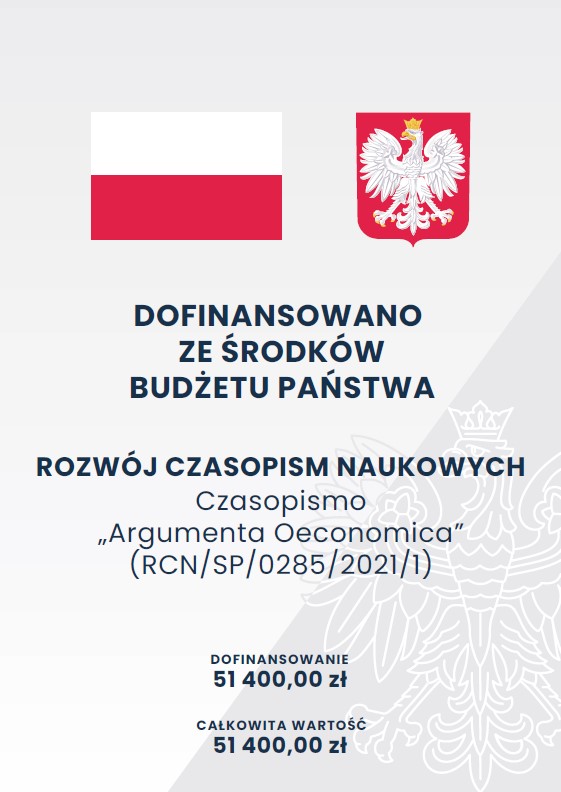Dynamics of consumer inflation with irrational expectations and exogenous economic shocks
DOI:
https://doi.org/10.15611/aoe.2025.2.08Keywords:
macroeconomic model, inflation, prices, simulation, heterogenous expectations, DSGE, behavioral macroeconomicsAbstract
Aim: Economic modelling has long relied on the assumption of individual rationality. Advances in the behavioural sciences and the problematic empirical fit of rational models have made this central assumption increasingly untenable. The article proposes an alternative and more realistic approach to model agents as forming diverse expectations.
Methodology: The study leverages the approach of heterogeneous expectations and shows how to formally incorporate behavioural heuristics into the expectations formation process. It presents the setup and computation of a small dynamic stochastic general equilibrium (DSGE) model, based on heterogeneous expectations and compares its dynamics to the rational expectations benchmark.
Results: The DSGE model shows that an economy with heterogeneous expectations generates business cycles of its own through the mechanism of self-fulfilling prophecies. As agents’ expectations diverge from rationality, the economy drifts away from its potential output and extreme inflation episodes ensue. A comparison with empirical data from the European Union serves to further corroborate and validate model insights.
Implications and recommendations: This outcome underlines the importance of sentiments as drivers of price dynamics and proposes a viable alternative for modelling them. The results show the importance of complementing current mainstream modelling with more psychological insights on the microfoundations of agent behaviour to better approximate the workings of the economic system.
Originality/value: The paper shows how alternative expectations formation mechanisms can be incorporated into a small DSGE model, and provides a simple but realistic way to formal model herding and validates its results through a comparison with actual statistical data from the European Union.
Downloads
References
Ang, A., Bekaert, G., & Wei, M. (2007). Do macro variables, asset markets, or surveys forecast inflation better? Journal of Monetary Economics, 54(4), 1163-1212.
Anufriev, M., Hommes, C., & Makarewicz, T. (2019). Simple forecasting heuristics that make us smart: Evidence from different market experiments. Journal of the European Economic Association, 17(5), 1538-1584.
Armantier, O., Bruine de Bruin, W., Topa, G., Van Der Klaauw, W., & Zafar, B. (2015). Inflation expectations and behavior: Do survey respondents act on their beliefs? International Economic Review, 56(2), 505-536.
Assenza, T., Heemeijer, P., Hommes, C. H., & Massaro, D. (2021). Managing self-organization of expectations through monetary policy: A macro experiment. Journal of Monetary Economics, 117, 170-186.
Atanasov, I. S. (2019). Uncertainty in social networks: A matter of opinions. IFAC-PapersOnLine, 52(25), 494-497.
Barberis, N., & Thaler, R. (2002). A survey of behavioral finance (9222). Technical report, National Bureau of Economic Research.
Bordalo, P., Gennaioli, N., Ma, Y., & Shleifer, A. (2020). Overreaction in macroeconomic expectations. American Economic Review, 110(9), 2748-2782.
Branch, W. A. (2004). The theory of rationally heterogeneous expectations: Evidence from survey data on inflation expectations. The Economic Journal, 114, 592-621.
Branch, W. A. (2007). Sticky information and model uncertainty in survey data on inflation expectations. Journal of Economic Dynamics and Control, 31(1), 245-276.
Branch, W. A., & Evans, G. W. (2006). Intrinsic heterogeneity in expectation formation. Journal of Economic Theory, 127(1), 264-295.
Brock, W. A., & Hommes, C. H. (1997). A rational route to randomness. Econometrica, 65(5), 1059-1095.
Burke, M. A., & Ozdagli, A. (2023). Household inflation expectations and consumer spending: Evidence from panel data. Review of Economics and Statistics, 105(4), 948-961.
Cagan, P. (1956). The monetary dynamics of hyperinflation. In M. Friedman (Ed.), Studies in the Quantity Theory of Money. University of Chicago Press.
Camerer, C. F. (2003). Behavioral game theory: Experiments in strategic interaction. Princeton University Press.
Caplin, A., Dean, M., & Leahy, J. (2019). Rational inattention, optimal consideration sets, and stochastic choice. The Review of Economic Studies, 86(3), 1061-1094.
Carroll, C. D. (2001). The epidemiology of macroeconomic expectations, Technical report. National Bureau of Economic Research.
Carroll, C. D. (2003). Macroeconomic expectations of households and professional forecasters. The Quarterly Journal of Economics, 118(1), 269-298.
Chauvet, M., & Guo, J.-T. (2003). Sunspots, animal spirits, and economic fluctuations. Macroeconomic Dynamics, 7(1), 140-169.
Chen, H.-J., Li, M.-C. ,& Lin, Y.-J. (2008). Chaotic dynamics in an overlapping generations model with myopic and adaptive expectations. Journal of Economic Behavior & Organization, 67, 48-56.
Clark, T. E., & Nakata, T. (2008). Has the behavior of inflation and long-term inflation expectations changed? FRBKC Economic Review, 93(1), 17-50.
Claus, E., & Nguyen, V. H. (2023). Biased expectations. European Economic Review, 154, 104424.
Coibion, O., & Gorodnichenko, Y. (2015). Information rigidity and the expectations formation process: A simple framework and new facts. American Economic Review, 105(8), 2644-2678.
Coibion, O., Gorodnichenko, Y., & Kamdar, R. (2018). The formation of expectations, inflation, and the Phillips curve. Journal of Economic Literature, 56(4), 1447-1491.
Coibion, O., Gorodnichenko, Y., & Kumar, S. (2018). How do firms form their expectations? New survey evidence. American Economic Review, 108(9), 2671-2713.
Coibion, O., Gorodnichenko, Y., Kumar, S., & Pedemonte, M. (2020). Inflation expectations as a policy tool? Journal of International Economics, 124, 103297.
Colander, D., Föllmer, H., Armin Haas, M. G., Juselius, K., Kirman, A., Lux, T., & Sloth, B. (2009). The financial crisis and the systemic failure of academic economics (1489). Technical report. Kiel Institute for the World Economy.
Cooper, B. R., & Willis, J. L. (2010).Coordination of expectations in the recent crisis: Private actions and policy responses. FRBKC Economic Review, 101(1), 5-39.
Cornand, C., & Hubert, P. (2021). Information frictions in inflation expectations among five types of economic agents. HAL Open Science, ID: halshs-03351632.
Curtin, R. (2007). Consumer sentiment surveys: worldwide review and assessment. Journal of Business Cycle Measurement and Analysis, 3(1), 7-42.
de Bruin, W. B., Vanderklaauw, W., Downs, J. S., Fischhoff, B., Topa, G., & Armantier, O. (2010). Expectations of inflation: The role of demographic variables, expectation formation, and financial literacy. The Journal of Consumer Affairs, 44(2), 381-402.
de Grauwe, P. (2010). Behavioral macroeconomics. Technical report. University of Leuven.
de Grauwe, P. (2012). Lectures on Behavioral Macroeconomics. Princeton University Press.
Devenow, A., & Welch, I. (1996). Rational herding in financial economics. European Economic Review, 40(3-5), 603-615.
Dominitz, J., & Manski, C. F. (2003). How should we measure consumer confidence (sentiment)? Evidence from the Michigan survey of consumers (W9926). Technical report. National Bureau of Economic Research.
Duffy, J. (2008). Experimental macroeconomics. New Palgrave Dictionary of Economics. Palgrave McMillan.
Duxbury, D. (2015). Behavioral finance: insights from experiments I: Theory and financial markets. Review of Behavioral Finance, 7(1), 78-96.
Evans, G. W., & Honkapohja, S. (2001a). Learning and Expectations in Macroeconomics. Princeton University Press.
Evans, G. W., & Honkapohja, S. (Eds.)(2001b). International Encyclopaedia of the Social and Behavioral Sciences. Elsevier Science, chapter Economics of expectations, pp. 5060-5067.
Friedman, M. (1957). A Theory of the Consumption Function. Princeton University Press.
Gabaix, X. (2020). A behavioral New Keynesian model. American Economic Review, 110(8), 2271-2327.
Gali, J. (2015). Monetary Policy, Inflation and the Business Cycle: An Introduction to the New Keynesian Framework and Its Applications, 2nd Edition. Princeton University Press.
Gerunov, A. (2019). Modelling economic choice under radical uncertainty: Machine learning approaches. International
Journal of Business Intelligence and Data Mining, 14(1-2), 238-253.
Gerunov, A. (2022). Humans in the network. In Risk Analysis for the Digital Age (pp. 197-239). Springer International Publishing.
Golinelli, R., & Parigi, G. (2004). Consumer sentiment and economic activity: A cross-country comparison. Journal of Business Cycle Measurement and Analysis, 1(2), 147-170.
Grandmont, J.-M. (1998). Expectations formation and stability of large socioeconomic systems. Econometrica, 66(4), 741-781.
Guerkaynak, R. S., Marder, A. N., Levin, A. T., & Swanson, E. T. (2007). Inflation targeting and the anchoring of inflation expectations in the western hemisphere. FRBSF Economic Review, 25, 25-47.
Holt, C. A., Porzio, M., & Song, M. Y. (2017). Price bubbles, gender, and expectations in experimental asset markets. European Economic Review, 100, 72-94.
Hommes, C. H. (2011). The heterogeneous expectations hypothesis: Some evidence from the lab. Journal of Economic Dynamics and Control, 35(1), 1-24.
Hommes, C. (2021). Behavioral and experimental macroeconomics and policy analysis: A complex systems approach. Journal of Economic Literature, 59(1), 149-219.
Hommes, C., Massaro, D., & Weber, M. (2019). Monetary policy under behavioral expectations: Theory and experiment. European Economic Review, 118, 193-212.
Hommes, C., Sonnemans, J., Tuinstra, J., & van de Velden, H. (2005). Coordination of expectations in asset pricing experiments. The Review of Financial Studies, 18(3), 954-980.
Johansen, S. (1991). Estimation and hypothesis testing of cointegration vectors in Gaussian vector autoregressive models. Econometrica, 59(6), 1551-1580.
Jung, J., Kim, J. H., Matejka, F., & Sims, C. A. (2019). Discrete actions in information-constrained decision problems. The Review of Economic Studies, 86(6), 2643-2667.
Kacelnik, A. (2006). Meanings of rationality. In S. Hurley & M. Nudds (Eds.), Rational Animals (pp. 87-106). Oxford University Press.
Kirman, A. (2010). The economic crisis is a crisis for economic theory. CESifo Economic Studies, 56(4), 498-535.
Knotek, E. S., & Khan, S. (2011). How do households respond to uncertainty shocks? Federal Reserve Bank of Kansas City Economic Review, Second Quarter 2011, 63-92.
Koetsier, I., & Bikker, J. A. (2022). Herd behavior of pension funds in sovereign bond investments. Journal of Pension Economics & Finance, 21(4), 475-501.
Komalasari, P. T., Asri, M., Purwanto, B. M., & Setiyono, B. (2022). Herding behaviour in the capital market: What do we know and what is next? Management Review Quarterly, 72(3), 745-787.
Lux, T. (1995). Herd Behaviour, Bubbles and Crashes. The Economic Journal, 105(431), 881-896.
Lux, T. (2009). Rational forecasts or social opinion dynamics? Identification of interaction effects in a business climate survey. Journal of Economic Behavior & Organization, 72, 638-655.
Maćkowiak, B., Matějka, F., & Wiederholt, M. (2023). Rational inattention: A review. Journal of Economic Literature, 61(1), 226-273.
Mand, A., Janor, H., Abdul Rahim, R., & Sarmidi, T. (2023). Herding behavior and stock market conditions. PSU Research Review, 7(2), 105-116.
Mankiw, N. G., & Reis, R. (2002). Sticky Information versus Sticky Prices: A Proposal to Replace the New Keynesian Phillips Curve. The Quarterly Journal of Economics, 117(4), 1295-1328.
Mankiw, N. G., Reis, R., Wolfers, J. Gertler, M., Rogoff, K. (Eds.) (2004). Disagreement about inflation expectations. NBER Macroeconomics Annual 2003, 18, 209-270.
Manski, C., & McFadden, D. (1981). Structural Analysis of Discrete Data with Econometric Applications. MIT Press.
Matejka, F. (2016). Rationally inattentive seller: Sales and discrete pricing. The Review of Economic Studies, 83(3), 1125-1155.
Mehra, Y. P., & Herrington, C. (2008). On the sources of movements in inflation expectations: A few insights from a VAR model. Economic Quarterly, 97(2), 121-146.
Melosi, L. (2017). Signalling effects of monetary policy. The Review of Economic Studies, 84(2), 853-884.
Mishkin, F. S. (1983). Are market forecasts rational? Rational expectations approach to macroeconomics: Testing policy ineffectiveness and efficient-markets models. National Bureau of Economic Research.
Muth, J. F. (1961). Rational Expectations and the Theory of Price Movements. Econometrica, 29(3), 315-335.
Nerlove, M. (1958). Adaptive Expectations and Cobweb Phenomena. The Quarterly Journal of Economics, 72(2), 227-240.
Pfajfar, D., & Santoro, E. (2010). Heterogeneity, learning and information stickiness in inflation expectations. Journal of Economic Behavior & Organization, 75, 426-444.
Pfajfar, D., & Zakelj, B. (2009). Experimental evidence on inflation expectation formation. Technical report. CentER, Tilburg University.
Roos, M. W. (2005). TV weather forecast or look through the window? Expert and consumer expectations about macroeconomic conditions. Kyklos, 58(3), 415-437.
Rudd, J. B. (2022). Why do we think that inflation expectations matter for inflation? (and should we?). Review of Keynesian Economics, 10(1), 25-45.
Sargent, T. J. (1993). Bounded Rationality in Macroeconomics. Oxford University Press.
Scharfstein, D., & Stein, J. (1990). Herd behavior and investment. American Economic Review, 80, 465-479.
Souleles, N. S. (2004). Expectations, heterogeneous forecast errors, and consumption: micro evidence from the Michigan consumer sentiment surveys. Journal of Money, Credit and Banking, 36(1), 39-72.
Spyrou, S. (2013). Herding in financial markets: A review of the literature. Review of Behavioral Finance, 5(2), 175-194.
Stevens, L. (2020). Coarse pricing policies. The Review of Economic Studies, 87(1), 420-453.
Thaler, R. H. (2016). Behavioral economics: Past, present, and future. American Economic review, 106(7), 1577-1600.
Tsenova, T. (2011). Are long-term inflation expectations well-anchored? Evidence from the Euro area and the United States (DP/83/2011). Technical report. Bulgarian National Bank.
Virigineni, M., & Rao, M. B. (2017). Contemporary developments in behavioural finance. International Journal of Economics and Financial Issues, 7(1), 448-459.
Walsh, C. (2003), Monetary Theory and Policy, MIT Press.
Downloads
Published
License
Copyright (c) 2025 Anton A. Gerunov

This work is licensed under a Creative Commons Attribution-ShareAlike 4.0 International License.
Accepted 2025-01-25
Published 2025-09-30








